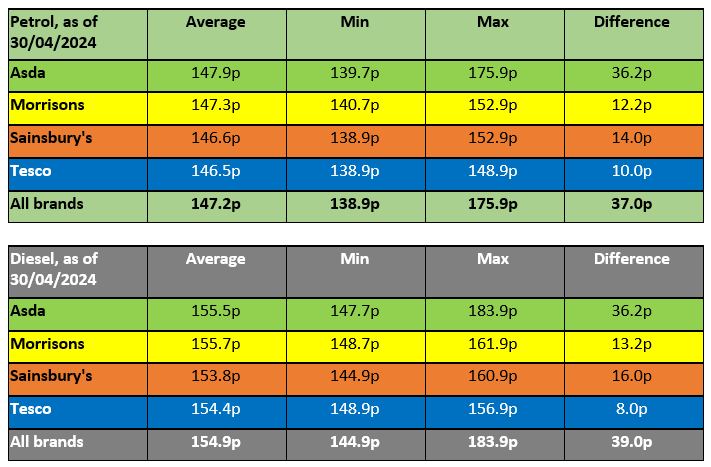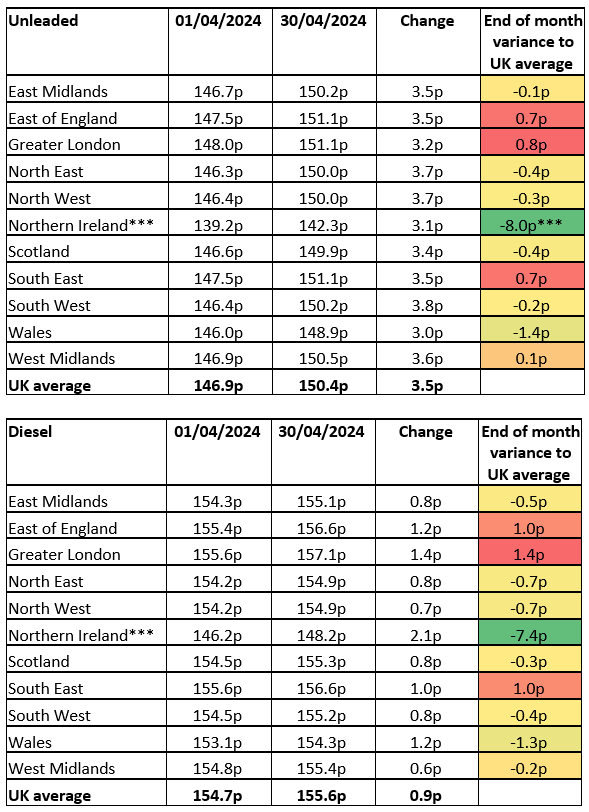Unleaded went up 3p last month to 149.95p while diesel rose by 2p to 157.76p, taking a 55-litre tank of petrol to £82.47 (up £1.70 in April) and diesel to £86.77 (up £1.10 in April).
The lowest prices for petrol and diesel so far this year were both recorded on 16 January – 139.7p and 147.6p respectively.
With the increases at the pump weighing heavily on household budgets, the RAC is calling on the Government and the Competition and Markets Authority (CMA) to address some glaring issues with fuel retailing which have been brought further to light since the country’s largest retailers first began voluntarily publishing their fuel prices on a daily basis last September.
The RAC wants the CMA, which is now responsible for monitoring prices alongside overseeing the imminent government-mandated ‘Pump Watch’ scheme, to tackle ongoing issues with unfair retailer margins which lead to drivers getting a raw deal on the UK’s forecourts – something clearly shown in the CMA’s market study which concluded drivers were overcharged by £900m in 2022.
The RAC believes that if the biggest retailers were to charge fairer margins, it would lead to:
- Fuel prices across the UK mainland coming down to match those charged in Northern Ireland which are consistently 5p a litre (£2.50 a tank) lower
- An end to the postcode lottery which sees individual retailers often charge wildly different prices at the forecourts they operate – these can vary by an average of 17p a litre from their cheapest to most expensive sites, but can be as high as 36p
- An end to ‘rocket and feather’ pricing which results in prices on the forecourt going up far more quickly in a rising wholesale market than they come down when wholesale costs fall
- Those driving diesel vehicles not being consistently overcharged. This is a regular occurrence borne from retailers upping margins on diesel to subsidise the price of petrol
RAC Fuel Watch data for April reveals that retailer margins have increased dramatically, despite the CMA expressing its concern about this very issue at the end of March.
The average margin on unleaded currently stands at 9.5p a litre, whereas margin on diesel has rocketed to 18p, up 6p in April alone. The long-term average margin for both fuels is just 8p.
Price of supermarket fuel
The RAC’s analysis of supermarket prices at the end of April shows that the differences between the cheapest and most expensive fuel charged by individual brands ranges from 8p a litre to 36p:
Looking at the forecourts operated by the two big oil companies – BP and Shell – there is also a vast difference between their high and low prices at the end of April. For petrol, BP’s price spread was 24p while Shell’s was 28p. The difference between BP’s cheapest and most expensive diesel was a shocking 30p while for Shell it was 28p.
RAC fuel spokesman Simon Williams said: “Drivers are once again having to dig deep just to go about their daily lives. Our data shows petrol and diesel have now gone up 10p a litre so far this year on the back of further increases in April of 3p and 2p respectively.
“Some of this is down to the oil price and the pound-to-dollar exchange rate making wholesale petrol more expensive for retailers to buy but unfortunately, it’s also very apparent that retailers are making massive margins on diesel. To put this into perspective, the wholesale price of diesel has been lower than petrol since the middle of April, yet diesel is nearly 8p a litre dearer at the pump. If retailers were treating drivers fairly this gap would be starting to close, instead of getting wider.
“This has prompted the RAC to call on the Government and the Competition and Markets Authority (CMA) to get to grips with unfair retailer margins once and for all via the imminent ‘Pump Watch’ scheme and the creation of a price monitoring body. Worryingly though, the CMA’s warning shot about higher retailer margins at the end of March appears to have fallen on deaf ears, meaning drivers are once again being seriously overcharged for diesel.
“We also badly need to bring fuel prices on the UK mainland down to match those in Northern Ireland. We can clearly see that the average cost of fuel in Northern Ireland is around 6p cheaper than the UK average, which is inexplicable**. While the same disparity between petrol and diesel exists, prices are still much lower than the rest of the UK.
“Finally, we look forward to other fuel retailer brands operating in Northern Ireland – such as Maxol, Go and SPAR – beginning to share their prices with the CMA, which will shed even more light on the pump price gulf that exists, and reinforce our call for retailers this side of the Irish Sea to do the right thing.”
Fuel prices around the UK
Motorists looking to save money on their fill-ups should take advantage of the fuel finder feature in the free myRAC app. The app can be downloaded for free from the App Store or Google Play.
Up to nine searches a day can be made over a two, five or 10-mile radius, with each giving the five cheapest prices.
The web page has more information about the average price of petrol and diesel at the big four supermarkets and at motorway services. It also features graphs showing average prices since 2000 as well as a daily financial breakdown of the cost of a litre of petrol and diesel.

SALE – up to 40% off*
Roadside & Recovery from £5.29 a month*
• Cheaper than AA Price Promise or we’ll beat by 20%^
• We get to most breakdowns in 60 mins or less
• Our patrols fix 4/5 breakdowns on the spot

* UK average pump prices quoted are based on Competition and Markets Authority data from 1-30 April 2024. Wholesale prices, oil price and the value of sterling are based on data from Fuel Prices Online from 2-30 April 2024
** Weekly data, updated every Thursday, from the Consumer Council of Northern Ireland shows the average price of petrol on 25 April 2024 was 143.8p while diesel was 150.3p.
*** Based on 36 supermarket forecourts operating in Northern Ireland reporting data to the CMA out of circa 580 forecourts. The average price of petrol in Northern Ireland on 25 April 2024 was 143.8p and diesel was 150.3p.











